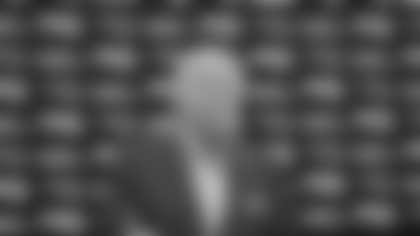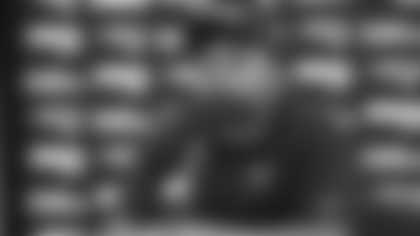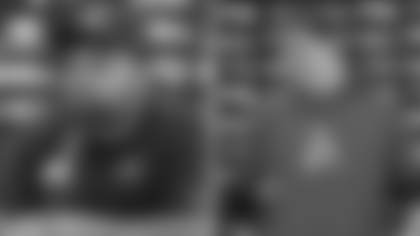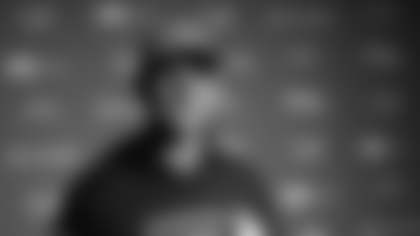BB: How was the weekend – good? Yesterday was a good day, kind of get caught up, get reorganized, sort of reevaluate some things from the first four days scheduling and practice-wise and figure out things we need to do here going forward, trying to maximize our time and our opportunity and get installed what we need to do, evaluate players, our scheme, get ready to play a game here in a little over a week. So, it's kind of a good day to get caught up. The first four days, we've taken some kind of movement in the right direction. Ultimately, we'll see how much, but I think we're trying. Players are trying to do what we ask them to do. We've got a long way to go. There are a number of moving parts, a number of things we'll have to sort out and figure out, and it'll all have to come together. We're just taking one step at a time, get back out there today and hopefully with yesterday's day off we'll be able to move up a level and make a little bit more progress. That's what we're hopeful for.
Q:When you have one week of joint practices as opposed to two, there are a lot of quality reps in those joint practices. Do you have to account for that as you lay out the next couple weeks?
BB: I think you're probably really talking about two to three days is what it really amounts to and the tradeoff would be the competition of those practices, measuring your scheme, looking at players in different matchups and that type of thing versus your development and your installation as a team. Whenever we've done that against another opponent or even this year doing it against New Orleans, I'd say the idea isn't to go in there and try to put in a bunch of new things. It would be to run what we have in to that point against that team. So, what you gain from that I think is kind of offset a little bit by the fact that you're not really putting in something, you're not advancing your scheme. You're kind of holding your scheme steady and trying to take the time to evaluate players. And there are certainly a lot of benefits to both. When you're practicing with yourself, then you kind of structure your practice where you can install something new. You work on it as an individual; you're working on it in group drills – nine on seven, seven on seven, half-line – whatever it is, and then you work on it as a team. And then you come off the field and you've put in something new, you've had a progression, and hopefully you have a better understanding, [and] you can do it. It's not really something I think you'd want to do – maybe a little bit of – but I'd say not very much of against another team. You want to run what you know, what you're confident in and see how it looks. Like I said, maybe what we're not getting on the competitive evaluation side, I think we have more time in terms of our installation than we had last year. So, there's a little bit of a tradeoff there. I don't know if it's good or bad, but whatever the time is we try to use it and get the most out of it, so that's what we're doing.
Q: Do you have any roster transactions to announce?
BB:We'll have some, yeah. He had to clean up a couple things, some physicals and all that, but I think we'll have some probably by the end of the day. We'll make sure you're the first to know.
Q: With Willie McGinest going into the Patriots Hall of Fame tomorrow, what stands out to you about his career with the team?
BB:Outstanding. I go back all the way to USC with Willie. I still remember in that spring meeting with him out there in their big team meeting room and watching film with him. He had kind of a little bit of an interesting career there at Southern Cal with Coach [John] Robinson where in his senior year it seemed like they played him in a different spot every week. One time he was a defensive end, then he was an outside linebacker, he played some middle linebacker, sometimes they moved him inside. They moved him around to a lot of different positons trying to free him up, and you could see his versatility and his athleticism and toughness and playmaking. But it was kind of hard to evaluate him because he was kind of doing something different every week. He didn't really get into a real good groove there. And then of course, Bill [Parcells] drafted him here, coached him in 1996, so that would have been like his third year. He was kind of an outside linebacker and then in 1996, we used him really as a defensive end in a four-man scheme, although he still played both. But again, I think that speaks to his versatility – outside linebacker to defensive end, then we had him playing outside linebacker for us in 2000, 2001, in those years. Versatile player, I thought he had a great … Really competitive guy, tough, team-oriented. Winning was really important to him; winning more than personal stats. He took losing hard, which I think that's a good thing, more than personal accomplishments. Great example for younger players. He had kind of that nice balance of being able to talk to a guy, but also you just watch him do it and that was a good example. It wasn't really all one or the other. He had a good rapport with his teammates. Nobody would mess with Willie. Nobody. He was the most, I'd say in the time that I've been here, there is maybe one player, I'd put him up there as the guy you just don't want to cross him. If it got to that point, it's better to back off than get into it with him. He was very well respected, as he should be. He was great athlete, great player, great teammate, versatile guy, [on] championship teams. He had a great career.
Q:Who was the other player? Did you say there was one other player that was up there with him in terms of not wanting to mess with him?
BB:No, I'd say of all the guys [since] I've been here, I would say he would be the one guy, and there's really nobody else that comes to mind that kind of in that same vein. He's just too well respected. Nobody would mess with him.
Q:One of the things that stuck out about him was the big plays he made in big games, like against the Colts.
BB: Yeah, he killed the Colts, absolutely. Willie was … I'd say [Lawrence] Taylor was a little bit like that at New York. I kind of learned from coaching Lawrence that Lawrence is really smart and he played hard, he was really tough, but he had a little bit of extra gas in his tank for the critical plays in the game. So, we can all sit there and watch a game and here it is, we're ahead, there's not much time left, it's third down, this is going to be one of the plays of the game, well that's when you'd get one of his best plays. Lawrence always had a little bit left for, and he would be able to know, we need this play to win this game, or here are three or four plays in this game, and you were going to get his best on those plays for sure. There may have been a couple other ones that could've been better. And Willie was kind of like that, too. I remember talking to Willie about that, having that same conversation, and I think as a coach, as a player, as a fan, you sit there and watch the game, you can feel this is a big play coming up here. And those kinds of guys – McGinest and Taylor – they had that ability to reach down at that point in time and give their best and in a lot of cases make the difference. He had a lot of those plays, and not just rushing the passer either – against the run, blowing up a short yardage play where somebody else ends up making it. So, I think there's a little bit of that gamesmanship maybe is the right word – but knowing this is it, and I'm going to reach down, I've got a little bit extra and here it is.
Q:Do you ever break out the game film of Willie or Lawrence and show guys on the team today?
BB: Yeah, we talk about different things from time to time. Tedy [Bruschi], Troy [Brown], yeah, we go back and see some of that sometimes – Rodney [Harrison].
Q: When you point those things out, are you showing them to the technique?
BB: It could be anything. There are probably 100 things you could show them that are good. It depends on the player, the situation and what point you're trying to make. But yeah, I mean, those guys are great for a reason and if you can pass that on to the next generation somehow, yeah, we'll do it. We'll find any way to teach that's beneficial. We'll try to use it, you bet.
Q:You've been a big proponent of trying to move the extra point back, and now that the rule change has been instituted, will you change the way you approach it and the way you practice it?
BB:Yeah, of course, we'll practice it the way it is. I mean, you could still end up kicking a shorter field goal, particularly from a hash mark and changing the angle for the kicker and all that. Yeah, absolutely, we'll practice the extra points from where they're going to spot them this year and probably spend a little bit more time in terms of our preparation – I don't think it'll be dramatic – but just a little bit more time on two-point plays in case teams decide to use that strategy.
Q:Will you play the point or points after differently during the season?
BB: We've talked a little bit about that. Again, I think it's kind of a marginal thing. I don't think the pendulum swung one way or the other, but I think marginally it's a little bit more towards a two-point attempt than an extra point. But still, even extra point numbers from the 15-yard line are still in the high 90's, but it's not 99.6 or whatever it's been. We're talking marginally, but it's still a difference. I don't think it will have a dramatic shift in the strategy, but I think we'll have some in certain situations and we'll have to be conscious of that. Again, to me the extra point was automatic. When you're talking over 99 percent, it's an automatic play. Now, it's less than that. It's still high, but it's less than that.
Q:What are the dynamics of having two big tight ends together in the red zone?
BB: Well, I think the main thing in the red zone, whoever you're throwing to, somehow that person has to create some separation with the defense, and it's hard because there's not very much space and the defense is taught to get on those guys quickly. So, whether it's quickness, size, I'd say ability to catch the ball away from your body with great hands consistently, maybe a person that excels in a particular route, the technique of it like a fade or a slant or some type of push-off contact play to create separating. But it's hard to get open down there and there's not a lot of space. If the defense drops seven against five or eight against five, which teams are doing a little bit more of that, going with a three-man rush to get that extra guy in coverage, it's just really tight, so any player that can separate, whether it's size, quickness, hands, technique, makes them a good red-area receiver. I don't think it has to be a tight end or not a tight end – it can be anybody – but the ability to do that is what makes them good. Obviously, bigger is better, particularly when a lot of throws in the red area are at the back end line, high up by the cross bar on the goal post – those high throws in the back of the end zone. That just gives the quarterback a little bigger target, but the guy has got to have good hands to be able to bring the ball down and make a tough catch. Just being tall might help, but without good hands, jumping skills, timing, concentration, then that's only one component of it.
Q:How hard is it for Rob Gronkowski to continue having success in that area when the defense knows there is a high probability it's coming?
BB:I don't know. That's why we have other players on the team. They can't double cover everybody. They've only got 11 guys out there. If one player draws coverage, then that lightens the load somewhere else. If the coverage is somewhere else, then we have individual matchups and sooner or later we're going to have to win them as individual matchups. Every pass doesn't go to the same guy. That's why we have everybody else out there.








































